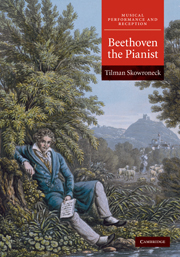Book contents
- Frontmatter
- Contents
- Acknowledgments
- Abbreviations and conventions
- Introduction
- PART I BEETHOVEN, HIS PLAYING, AND HIS INSTRUMENTS
- Introduction
- 1 Beethoven's early training
- 2 Beethoven the pianist
- 3 Beethoven's first decade in Vienna
- 4 The 1803 Érard grand piano
- PART II SOUND IDEAL AND PERFORMANCE
- PART III SOUND IDEAL, NOTATION, AND STYLISTIC CHANGE
- Epilog
- Bibliography
- Index
1 - Beethoven's early training
from PART I - BEETHOVEN, HIS PLAYING, AND HIS INSTRUMENTS
Published online by Cambridge University Press: 06 July 2010
- Frontmatter
- Contents
- Acknowledgments
- Abbreviations and conventions
- Introduction
- PART I BEETHOVEN, HIS PLAYING, AND HIS INSTRUMENTS
- Introduction
- 1 Beethoven's early training
- 2 Beethoven the pianist
- 3 Beethoven's first decade in Vienna
- 4 The 1803 Érard grand piano
- PART II SOUND IDEAL AND PERFORMANCE
- PART III SOUND IDEAL, NOTATION, AND STYLISTIC CHANGE
- Epilog
- Bibliography
- Index
Summary
LUDWIG THE ELDER'S AND JOHANN'S PROFESSIONAL TRAINING
The story of music instruction within the Beethoven family is a story of a short but apparently consistent tradition. Ludwig van Beethoven the elder, Beethoven's grandfather, was born in 1712 in Flemish Mechelen as the son of a baker who also traded in various goods. When he was almost six, he was admitted to the choirboy school of the cathedral of St. Rombaut in his hometown, where he stayed until he was thirteen. At that point, in 1725, the cathedral's organist Antoine Colfs took over his education, for payment and the guarantee that “the student was to substitute at the organ at the master's discretion without recompense.” Colfs taught Ludwig to play the organ, to accompany, and to play figured bass. At the age of nineteen Ludwig can be found as a singer of the tenor (in the Gregorian sense) at St. Peters in Leuven, where he later became choir director. His subsequent career is one of a fully trained and capable musician.
As far as we can see, Ludwig the elder's musical education was traditional and goal-oriented; it seems to have been well organized and, above all, successful. The contract that informs us about the organ and basso continuo lessons naturally conveys nothing about their spirit or Colf's pedagogical approach, and little about the lessons' actual content. However, the circumstances suggest apprenticeship rather than artistry, tradition rather than novelty, and a blend of learning and professional practice.
- Type
- Chapter
- Information
- Beethoven the Pianist , pp. 13 - 34Publisher: Cambridge University PressPrint publication year: 2010



